Читать книгу AutoCAD For Dummies - Ralph Grabowski - Страница 62
Zoom, Zoom, Zoom
ОглавлениеBecause zooming is a frequent activity in AutoCAD, you should know some alternative ways to zoom.
In addition to using the mouse’s roller wheel and the Zoom button on the Navigation bar (as I describe earlier in this chapter), you’ll find tool buttons for all the Zoom options in the Navigate panel on the View tab.
As mentioned, the Navigate panel on the View tab is turned off by default.
Click the small down arrow in the lower-right corner of the panel and a menu with the other options opens, as shown in Figure 5-2.
The Zoom command has 11 options. The most important ones are described in this list:
Extents and All: The Zoom Extents button (with the four-headed arrow and the magnifying glass) zooms out just far enough to display all objects in the current drawing. The Zoom All button (the sheet with the folded-over corner) does almost the same thing: It zooms to display the rectangular area defined by the drawing limits set with the LIMITS command, or it zooms to show the extents — whichever is larger. These two options are especially useful when you zoom in too close or pan off into empty space and want to see the entire drawing again. Limits and extents are slightly different. Limits are set by the Limits command. You can configure AutoCAD to not allow you to draw anything outside the limits, but this usually causes more problems than it solves. Extents are defined by the smallest imaginary rectangle that will just surround every object in your drawing. A good April Fool’s trick is to sneak up to another person’s computer and draw a tiny circle by typing the location coordinates as something like 10000,10000. The next time the person does a Zoom Extents, the drawing will seem to disappear. Use Zoom All or Zoom Extents and then save the drawing before you close it to ensure thatThe next person who opens the drawing can see the full drawing as soon as the person starts working.FIGURE 5-2: A menu for magnifying.Any objects that you accidentally copied beyond the drawing limits show up so that you can delete or move them.The drawing preview that appears in the Select File dialog box and on the Start screen displays the full drawing rather than a tiny, unidentifiable corner of it.
Window: This option, which is useful for zooming in quickly and precisely, zooms to a rectangular section of the drawing that you specify by clicking two points. The two points define the diagonal of a window around the area you want to see. The Zoom command’s Window option is not a click-and-drag operation, unlike in most other Windows programs and — confusingly — unlike in the Zoom/Pan Realtime Zoom Window option. To use the Zoom command’s Window option, you click to specify one corner, release the mouse button, and then click another corner.
Realtime: Enables you to zoom in and out by starting a real-time zoom and then dragging the magnifying-glass cursor up (to zoom in) or down (to zoom out).
Previous: Use this option to undo the last zoom or pan sequence (or both), returning to where you started. You can repeat this option to step through previous views, even if you create or edit objects after changing the view.
Object: This option zooms in close enough to show selected objects as large as they can be displayed onscreen. Using Zoom Object is similar to examining selected objects under the AutoCAD microscope.
Entering the keyboard command sequences Z A, Z P, or Z W (note the mandatory space between the letters) is usually faster than trying to find the corresponding zoom tools on the Ribbon or various toolbars. Z is the command alias for the Zoom command, while A, P, and W start the All, Previous, and Window options, respectively. These three command sequences, in combination with the wheel mouse, typically account for more than 99 percent of your panning and zooming needs. (I almost never use any Ribbon or navigation bar options.)
I cover another important Zoom option when discussing paper space viewports in Chapter 12.
